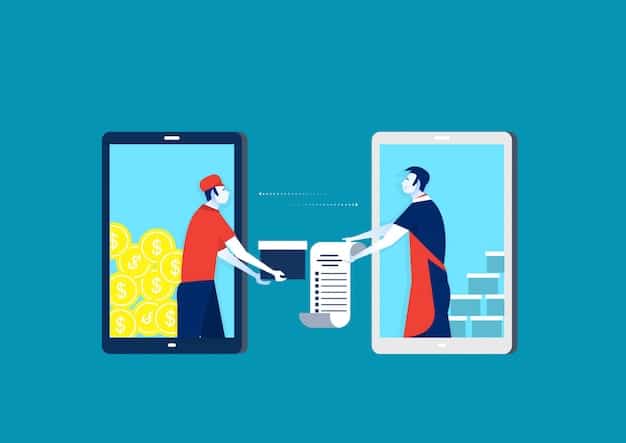Mobile Payment Optimization: Boost US E-Commerce Conversion by 10%

Mobile payment optimization is essential for US e-commerce businesses aiming to increase conversion rates, focusing on streamlined processes, diverse payment options, and enhanced security measures tailored to mobile users.
Are you struggling to convert mobile traffic into sales on your US e-commerce site? Don’t let clunky checkout processes cost you customers. Learn how mobile payment optimization can increase conversion rates by 10% with effective strategies tailored for the US market.
Understanding the Mobile Payment Landscape in the US
The mobile payment landscape in the US is rapidly evolving, requiring e-commerce businesses to stay informed and adapt quickly. Understanding current trends and consumer preferences is the first step towards effective mobile payment optimization.
Several factors are shaping the mobile payment environment, including increasing smartphone usage, the rise of mobile wallets, and consumer demand for seamless and secure transactions.
Key Trends in US Mobile Payments
Staying ahead of the curve means understanding the shifts in how Americans pay on their mobile devices. Here’s what you need to know:
- Mobile Wallets Dominate: Services like Apple Pay and Google Pay are gaining traction, offering faster and more secure checkout experiences.
- Increased Adoption of Buy Now, Pay Later (BNPL): BNPL options are becoming popular among younger demographics for their flexibility and convenience.
- Focus on Security: Consumers are increasingly concerned about data security, making secure payment gateways a must-have.
- Demand for One-Click Payments: Streamlined checkout processes, such as one-click payment options, are driving higher conversion rates.
Understanding these trends allows businesses to make informed decisions about which mobile payment options to offer and how to optimize the payment process.
Analyzing Your Current Mobile Payment Process
Before implementing new strategies, it’s crucial to analyze your existing mobile payment process. Identifying pain points and areas for improvement can help you prioritize changes and maximize their impact.
A thorough analysis involves evaluating the user experience, transaction success rates, and the range of payment options you currently offer.
How to Conduct a Mobile Payment Audit
A comprehensive audit will reveal where your current system falls short.
- Evaluate User Experience: Test the mobile payment process on different devices and browsers to identify usability issues.
- Analyze Transaction Data: Examine transaction success rates, dropout points, and reasons for failed payments.
- Review Payment Options: Assess the range of payment methods offered and identify any missing popular options.
- Gather Customer Feedback: Collect input on their experience with the mobile payment process to understand their needs and frustrations.

By conducting a thorough mobile payment audit, you can gain valuable insights into the strengths and weaknesses of your current process and identify areas for optimization.
Optimizing Mobile Checkout for Speed and Convenience
Speed and convenience are paramount when it comes to mobile payments. A clunky, slow, or complicated checkout process can lead to abandoned carts and lost sales.
Streamlining the mobile checkout process involves minimizing the number of steps, simplifying form fields, and providing clear calls to action.
Strategies for a Faster Mobile Checkout
Implement these techniques to reduce friction and increase conversions.
- Simplify Forms: Reduce the number of required fields and use autofill options to expedite data entry.
- Enable Guest Checkout: Allow customers to complete purchases without creating an account.
- Optimize Button Placement: Ensure that call-to-action buttons are prominently displayed and easy to tap.
- Provide Progress Indicators: Show customers where they are in the checkout process to manage expectations.
Optimizing mobile checkout for speed and convenience not only improves the user experience but also significantly increases the likelihood of completing a purchase.
Offering a Variety of Mobile Payment Options
Catering to different customer preferences is crucial in the diverse mobile payment landscape. Offering a wide range of payment options ensures that customers can use their preferred method, increasing the likelihood of a successful transaction.
Popular mobile payment options include mobile wallets, credit and debit cards, and Buy Now, Pay Later (BNPL) services, each appealing to different segments of the customer base.
Popular Payment Methods for US Mobile Shoppers
Consider these options to capture more sales.
- Mobile Wallets: Integrate with Apple Pay, Google Pay, and Samsung Pay to provide seamless one-tap payments.
- Credit and Debit Cards: Accept major credit and debit cards, ensuring a secure and familiar payment option.
- Buy Now, Pay Later (BNPL): Offer BNPL services like Affirm, Klarna, and Afterpay to attract budget-conscious customers.
- Alternative Payment Methods: Consider integrating with services like PayPal and Amazon Pay for users who prefer these options.
By offering a wide variety of mobile payment options, you can cater to a broader range of customer preferences and increase your chances of completing a sale.
Enhancing Security and Building Trust in Mobile Payments
Security is a top concern for mobile shoppers, and building trust is essential for encouraging conversions. Implementing robust security measures and clearly communicating them to customers can alleviate concerns and increase their comfort level with making mobile payments.
Strategies for enhancing security include using encryption, tokenization, fraud detection systems, and displaying security badges and certifications.
Key Security Measures for Mobile Payments
Assure your customers with these actions.
- Use Encryption: Implement SSL encryption to protect sensitive payment data during transmission.
- Tokenization: Replace customer credit card data with a unique token to prevent data breaches.
- Fraud Detection: Employ fraud detection systems to identify and prevent fraudulent transactions.
- Display Security Badges: Show security badges and certifications to build trust and reassure customers.

By enhancing security and effectively communicating these measures to customers, you can build trust and encourage them to complete their mobile purchases.
Mobile Payment Optimization: A/B Testing and Continuous Improvement
Mobile payment optimization is an ongoing process that requires continuous testing and improvement. A/B testing different payment options, checkout layouts, and security messaging can help you identify what works best for your audience and refine your approach over time.
Regularly monitoring key metrics, such as conversion rates, transaction times, and customer feedback, will provide valuable insights for optimizing your mobile payment process.
Implementing A/B Testing for Mobile Payments
Fine-tune your strategy with these tests.
- Test Different Payment Options: Compare the performance of various payment methods to determine which ones resonate best with your customers.
- Optimize Checkout Layouts: Experiment with different form field placements, button designs, and progress indicators to improve usability.
- Refine Security Messaging: Test various security badges and messaging to see which ones build the most trust.
- Monitor Key Metrics: Track conversion rates, transaction times, and customer feedback to measure the impact of your changes.
By implementing A/B testing and continuously monitoring key metrics, you can optimize your mobile payment process for maximum conversion rates.
| Key Point | Brief Description |
|---|---|
| 📱 Mobile Wallets | Integrate Apple Pay, Google Pay for fast checkout. |
| 💳 BNPL Options | Offer Buy Now, Pay Later services to attract shoppers. |
| 🔒 Enhanced Security | Use encryption, tokenization for secure transactions. |
| ⚡ Streamlined Forms | Simplify checkout with minimal fields and autofill. |
Frequently Asked Questions
▼
Mobile wallets like Apple Pay and Google Pay are highly popular, along with credit/debit cards. Buy Now, Pay Later (BNPL) options are also increasingly favored among younger shoppers.
▼
Implement SSL encryption, use tokenization to protect customer data, employ fraud detection systems, and display security badges to build trust and reassurance.
▼
A streamlined and fast checkout process reduces friction, minimizes abandoned carts, and significantly increases the likelihood of customers completing their purchases on mobile devices.
▼
A/B testing involves comparing two versions of a mobile payment process to see which performs better. Test different options to refine your approach over time.
▼
Providing various payment options ensures you cater to different customer preferences, increasing the chances of completing sales and attracting a wider audience to your business.
Conclusion
Optimizing mobile payments is essential for e-commerce businesses in the US looking to enhance conversion rates. By focusing on streamlining the checkout process, offering diverse payment options, and ensuring robust security, businesses can create a seamless and trustworthy mobile shopping experience that drives sales.





